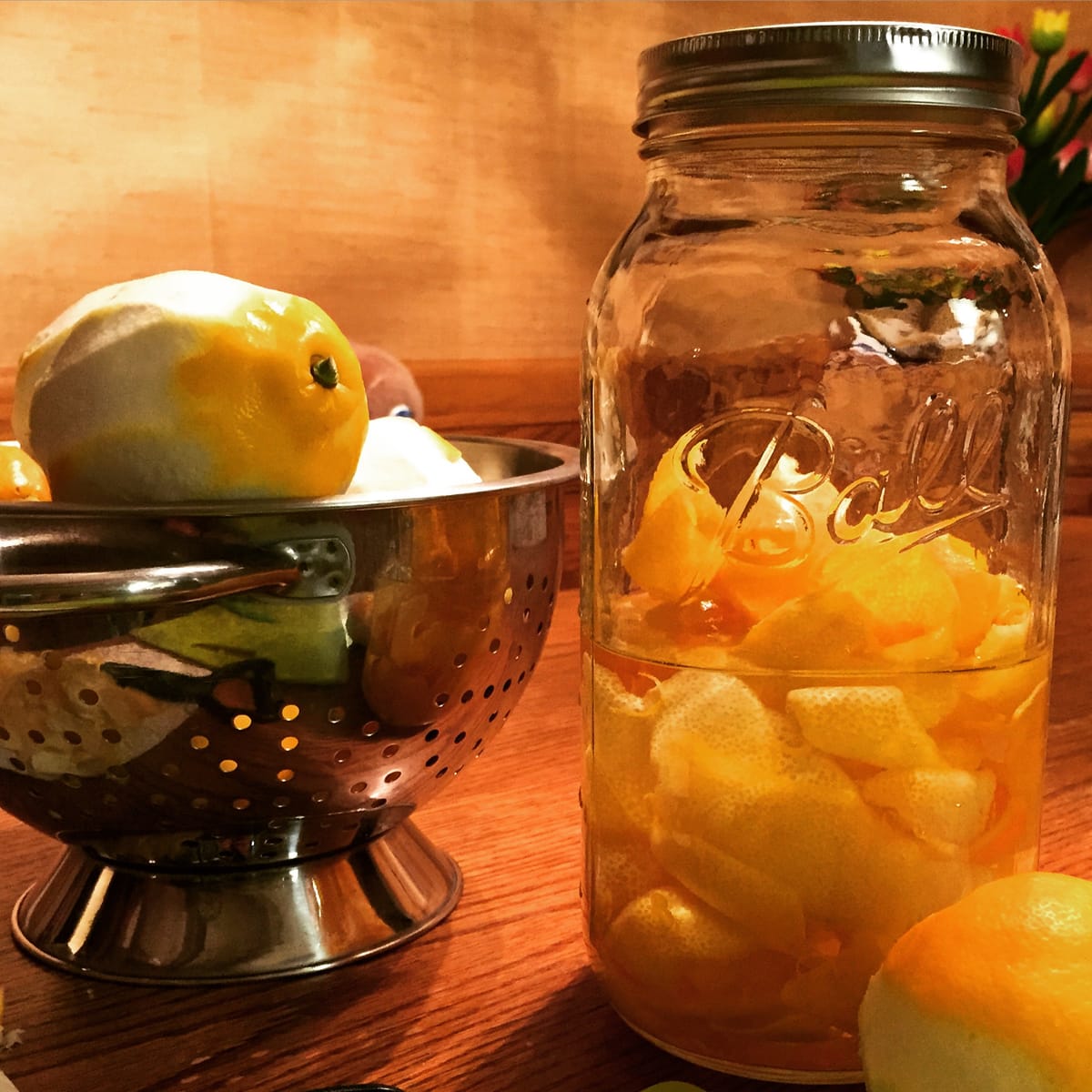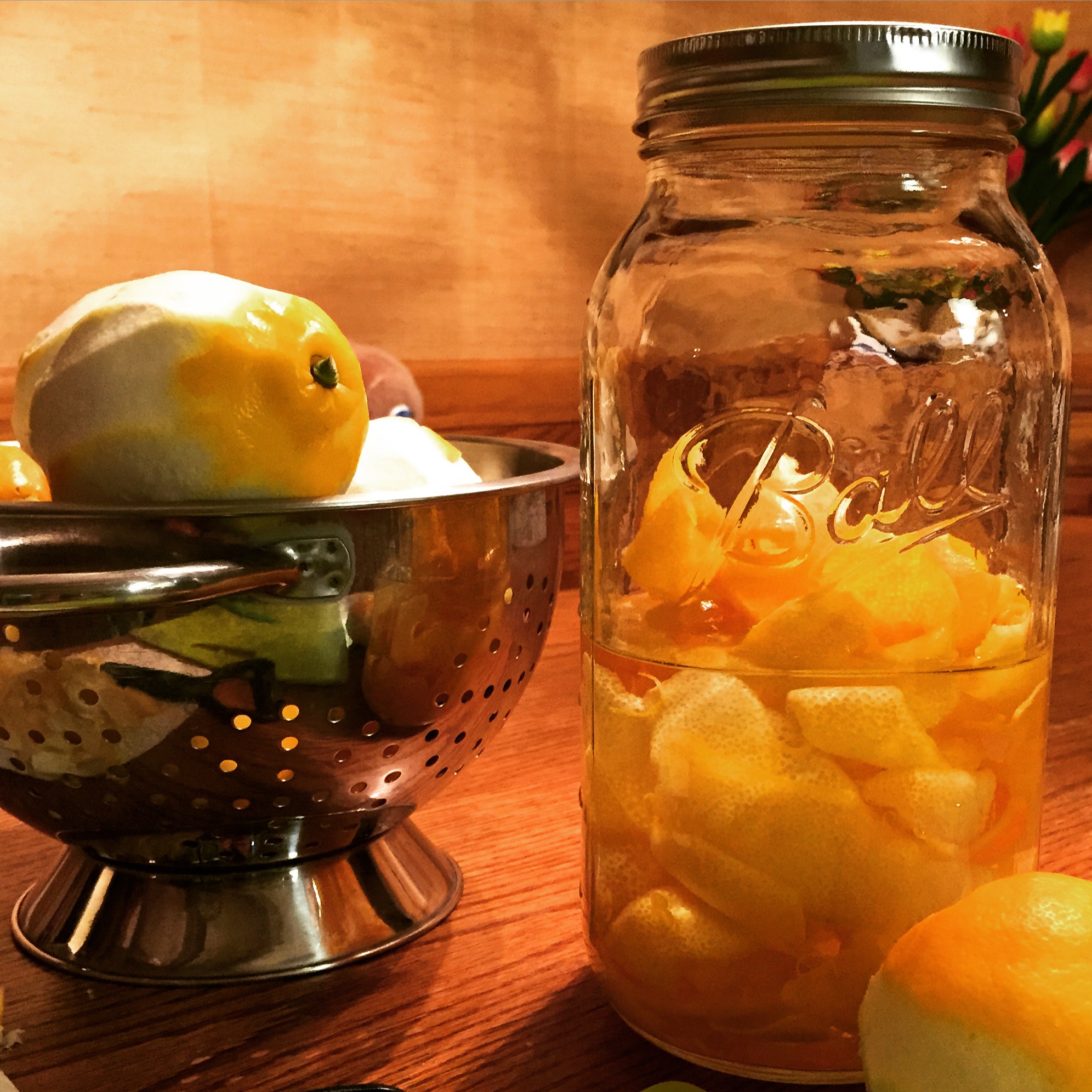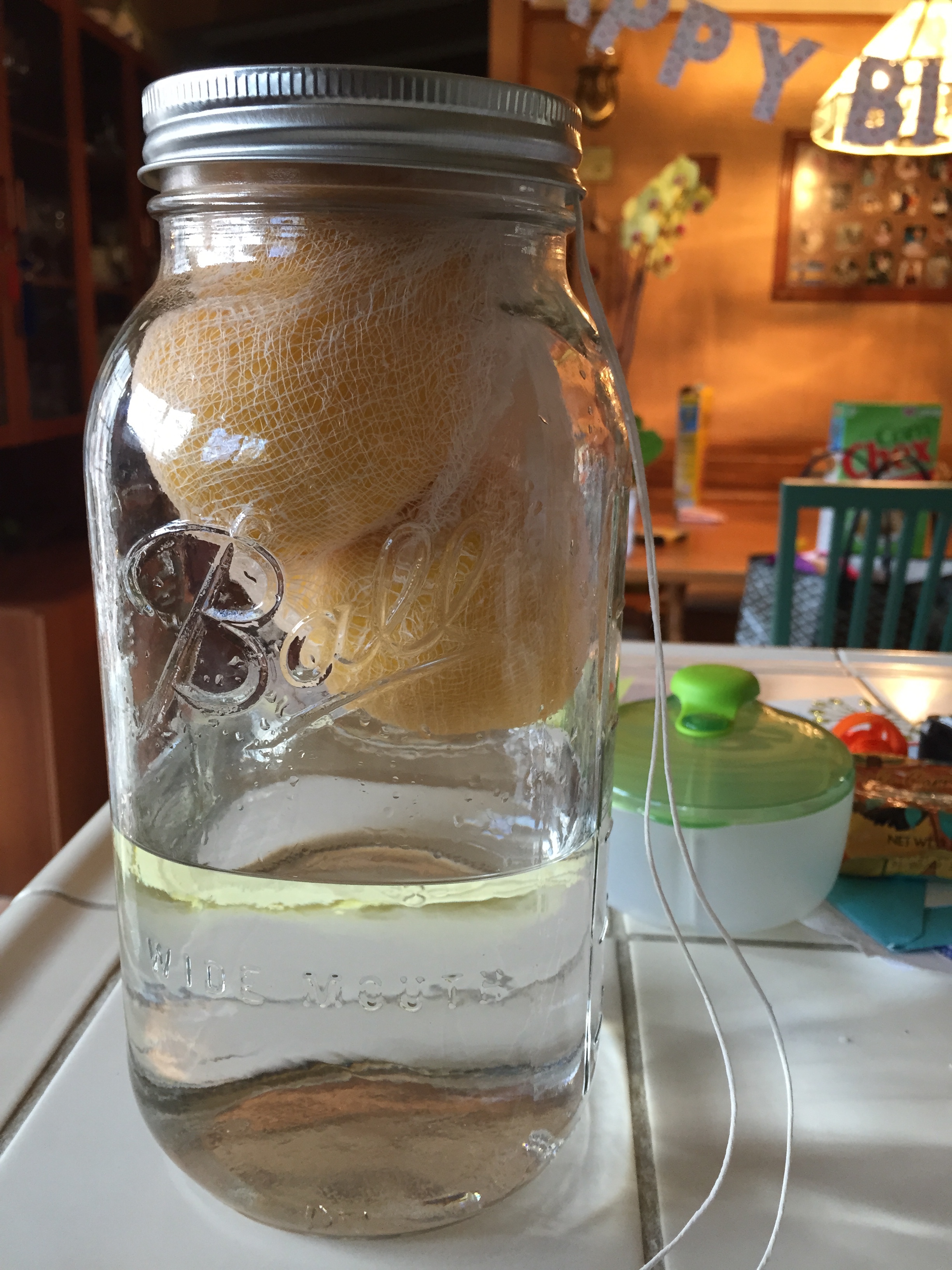Limoncello Two Ways

Limoncello is great. If done right it is an am amazing lemony elixer that signals the end of a gluttonous and sinfully satisfying meal. It is better than any dessert. Yeah, I said it. Fuck you, pot de creme. You are a steaming goopy pile of sugar dung next to the non-toxic anti-freeze qualities of a good 'cello.
The limoncello you can buy in the stores here are meh. First, they cheat by using food coloring to make them looks unnaturally yellow. Which is, obviously, why they look unnaturally yellow. Second, they're usually way too syrupy and sweet and taste like something used to lubricate a machine of some sort. No thanks.
I finally got fed up with yuck limoncello. It's time to just DIY.
I decided to experiment with two different methods. One is tried and true, the other just seems like a crazy science experiment that I don't understand (read: pure Hogwarts magic).
Winter is citrus season so organic Meyer lemons aren't too hard to find out here in California. My sister was nice enough to pick up five pounds worth and after a quick run to BevMo to pick up some 100 proof Stoli, I was ready to go.
Method No. 1: Steep it. Steep it real good.
Aside: Am I the only one whose soul died a little bit seeing Salt n Pepa in those Geico commercials? Like, they didn't just license the song. They were like "We'll be in the commercial if you give us each an extra $1,000." Sad face. You deserve better, Salt, Pep, and Spin.
ANYWAYS. There's no mystery re limoncello. It's lemon peels, high-proof grain alcohol, a big ol jar, sugar, water, and time. This is what I did for a recipe that will take 90 days total.

Perfect for podcast listening.
1 750 ml bottle of 100 proof vodka. I splurged for the Stoli ($30) but there's a 100 proof Smirnoff for $15 too. If you can't find 100 proof, just use the standard 80 proof vodka. It'll just take more time.
9-10 organic lemons. Yes, they have to be organic and no it's not because I'm a California asshole. You're using the peels and steeping them in alcohol to pull all the oils out. If there's other shit in or on your peel that's going to be in your alcohol too. So go buy the organic ones (Whole Foods or a farmer's market should do it) and then go eat a Big Mac to make yourself feel better. Or maybe I'm projecting here.
2 cups of simple syrup. This is for later. Just equal parts sugar and water, dissolved either via boiling or vigorous shaking.
Step 1: Wash your lemons super good. Now it's time to get the peels. You can either zest them or peel them with a peeler but the most important thing is DON'T LET THE DAMN PITH GET IN YOUR BATCH. The pith is that spongy white stuff between the peel and the fruit. You know, the side that goes against your teeth when you put orange slices in your mouth and run around like an idiot. That shit has to go. It is bitter and if you put it in with the alcohol your final product will be bitter.
My method: Peel the lemons with a fruit peeler and then, using a very sharp knife, filet the pith off each slice. It's slow and can take some time, but I threw on a Slate podcast and it was super meditative. I was actually sad when I was done.
Step 2: If you want to be super hard core you can filter your vodka here by running it through a Brita filter to remove any impurities or flavors that shouldn't be in there. I don't have a Brita filter so I didn't, but if I did I would have. Vodka isn't supposed to taste like anything but sometimes it does and you want your limoncello tasting like limoncello, not like limoncello vodka.
Step 3: Combine your de-pithed lemon peels and your vodka into a good sized jar. I use mason jars because that's what we have lying around the house, the residual effect of my mother planning a "rustic wedding" and overbuying on decorations because, you know, mom. Screw on the lid super tight and mark the jar with the date. Count 45 days ahead. Write down that date too. Also note the number of lemons you used, what kind they were, and the brand of vodka you used. That way if the batch turns out perfect you know the exact recipe. If it didn't, you know how to start adjusting.
Step 4: Put the jar in a cool dark place where the temperature stays constant, like the back of a closet or pantry or something.
Step 5: Wait 45 days. Every once in a while, check on your batch to make sure it looks good and give it a good shake.
Step 6: Now it's time to sweeten things up. Make a simple syrup and let the mixture cool. Add a quarter of it to your batch and take a taste. Not sweet enough? Add a little more. Keep doing that until it tastes super good, then screw the lid back on and put it back in your secret spot. Whatever you do though, don't over do it. You can always sweeten it again later. But you can't unsweeten it. That said, if you serve your limoncello at freezing, which is what you're supposed to do, it will taste less sweet anyway.
Step 7: Wait 45 days.
Step 8: Ta dah! It's pretty much done. All you need to do is strain it and pour it into whatever bottles you want to store it in. You can strain/filter it through a coffee filter, just make sure you wet and rinse the coffee filter first so that it doesn't impart any flavor to your liquor and it also doesn't steal some of your liquor by absorbing it. As for bottles, anything works but try to make sure it's freezer proof (also use a food-safe funnel to pour it in). I save all my old liquor bottles, scrape the labels off, and use those. Store your limoncello in the freezer to make sure it's always at optimum drinking temperature.
So I'll check back in March and let you know how this goes. Who knows, maybe I'll bring it down to Indian Wells and sip it while I watch Flavia Pennetta defend her title. Or...something?
Method 2: You Have To Believe We Are Magic
Dudes, I suck at science. My parents are scientists and engineers and that gene never got passed on to me and my sister. I have no fucking clue how or why this works. But apparently it does. I've never tried it before but after reading this and this I couldn't keep my curiosity at bay.
Basically you take a couple of lemons, put them in cheesecloth, hang them OVER the liquor, seal it up, and wait. APPARENTLY fumes from the alcohol get all up into the lemon peels, mastication begins to occur, and all the essential citrus oils leach out and drip into the alcohol below. As that NYT article says, it's not entirely dissimilar to how gin distillers get their botanicals into the gin.
What I like about this method (in theory) is that it only takes a few lemons (as opposed to the 10 in the first method) and you don't have to worry about de-pithing. Theoretically, this should just pull out the oils, and leave the bitterness in the fruit. That's exactly what you want. It should also yield a cleaner and lighter drink. But we'll see.
What I'm not convinced about the idea that it would only take a couple of lemons to fully flavor 750 ml of vodka. That just can't be right but that's what the Gizmodo recipe says. I'm also not convinced these lemons aren't going to go all fungal and shit. But again, science.
So here's the Gizmodo recipe, which I liked more than the NYT one simply because it finishes the batch with some fresh zest to brighten things up. I also tweaked it a bit.

Looked simple enough...
1 750 ml vodka. They used regular old Skyy, which is 80 proof, but I had purchased two bottles of the 100 proof Stoli so that's what I used.
2 organic Meyer lemons. Same rules apply as in Method 1. If it's in or on the lemon it's going into your drink. Let's say no to unwanted chemicals in our homemade liquer.
Cheesecloth, rinsed.
Twine
A wide-mouthed jar. Big and deep enough to put two lemons and have them hover over the 750 ml of liquid.
1.5 cups of simple syrup (50/50 water and sugar solution). This is for later.
Zest of two new, fresh Meyer lemons. This is for later.
Step 1: Pour the vodka into your jar.
Step 2: Take two large pieces of rinsed cheesecloth and criss cross them so they lay over the mouth of your jar.
Step 3: Carefully put the two lemons into the cheesecloth/jar until they both sit inside the jar but above the vodka.
Step 4: Carefully take the lemons out while leaving that cheesecloth pouch and use the twine to secure the cheesecloth around the lip of the jar. Make sure you can still screw on the lid.
Step 5: Put the lemons back in so they're sitting on the cheesecloth and hovering above the liquid. Seal the jar tightly. Write the date and the details of the batch on the jar.
Step 6: Move the jar to a cool, dark place and let it sit undisturbed for one month. Check on it every once in a while to make sure the color stays yellow. Don't open the jar, but If your spirit starts to look brown then the process has reached over-extraction and it's time to take the lemons out.
Step 7: Open the jar after a month (or if the extraction is done) and throw the lemons away. Add the simple syrup and the fresh lemon zest and let it sit for 15 minutes.
Step 8: Strain the liquid via a fine sieve or cheesecloth, and transfer to your bottles. Ta-dah! Science!
This should be ready by the time I return home from the Australian Open. What better way to unwind.
I'll let you know how this all turns out. Excited!



